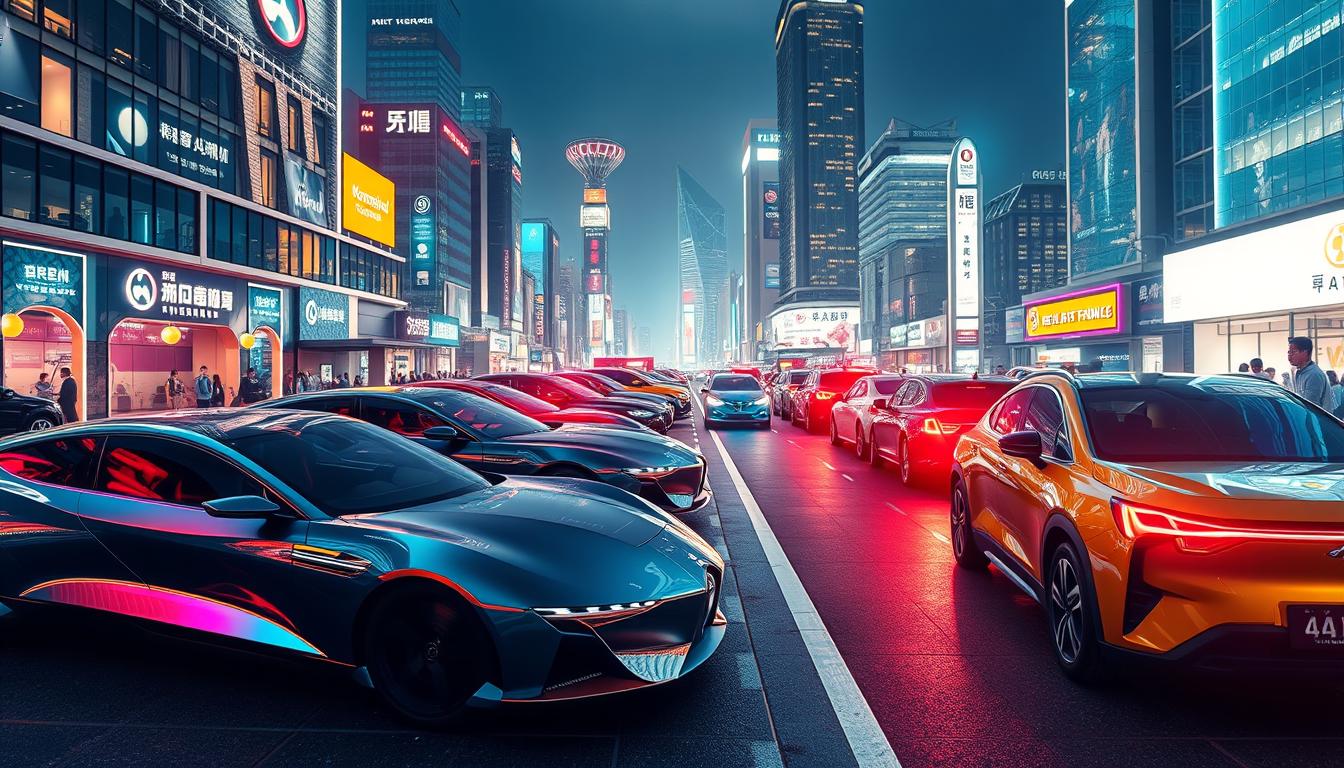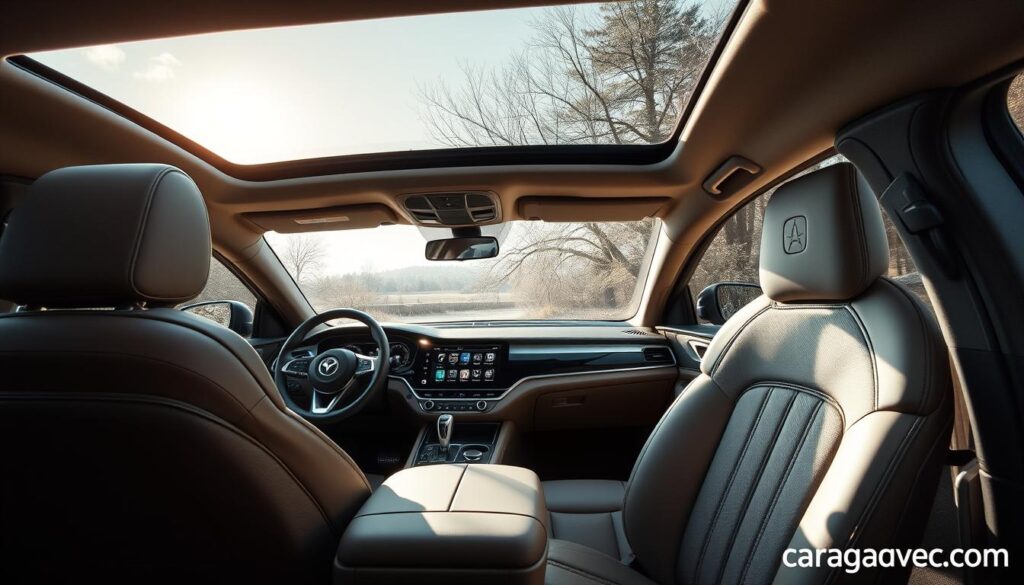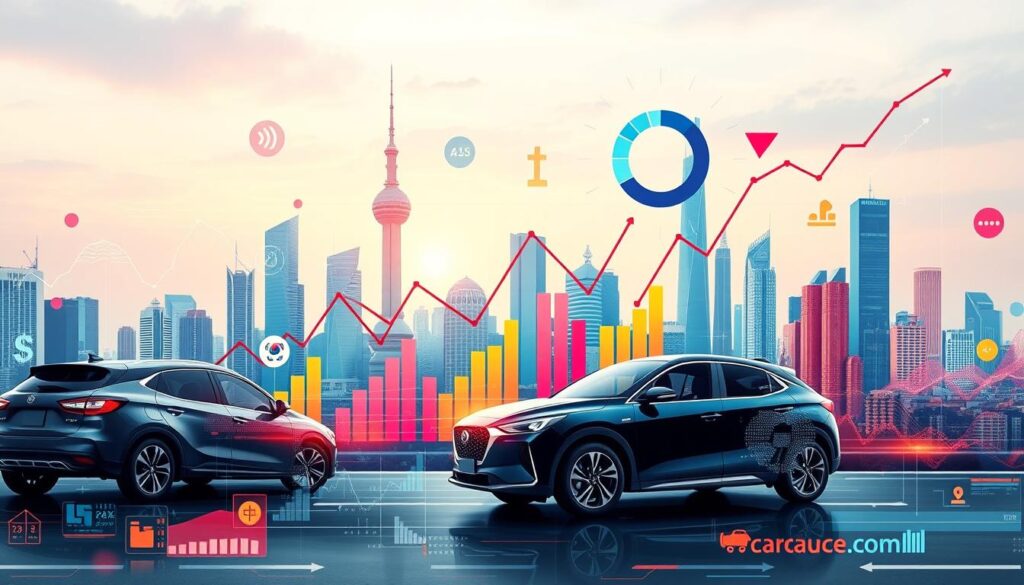
In today’s fast-paced automotive landscape, one might wonder: can Korean cars truly compete with established giants like BMW and Mercedes-Benz, or do they remain a mere shadow in the automotive industry? This modern drive guide will explore how South Korean car manufacturers have transformed their vehicles through innovation, design, and sustainability, challenging preconceived notions about their craftsmanship and technological prowess.
The past few decades have seen a remarkable transformation within the Korean car market. Once known primarily for affordable and utilitarian vehicles, brands like Hyundai, Kia, and Genesis have made significant strides in both design and functionality. As the demand for modernity and environmental consciousness grows, Korean manufacturers are setting the pace for others to follow. Join us as we delve into the intricacies of Korean cars, revealing the factors that contribute to their rising prominence on the world stage.
Key Takeaways
- Korean cars have evolved significantly, blending tradition with modern innovations.
- Key brands include Hyundai, Kia, and Genesis, each with a unique approach.
- Design and technology play crucial roles in the modern automotive landscape.
- Sustainability is at the forefront of development within the industry.
- The global appeal of Korean cars continues to rise amid increasing competition.
Introduction to Korean Cars: A Modern Perspective
The history of Korean cars reflects a remarkable journey of transformation and growth in the automotive sector. From humble beginnings, the industry has burgeoned into a global player, marked by significant milestones and evolving standards. This section delves into the essential aspects of the Korean automobile industry, focusing on the evolution of technology, design advancements, and the critical importance of automotive modernity in maintaining competitive positioning within the market.
Brief History of Korean Automobiles
The automotive landscape in South Korea began to take shape in the early 1960s. In 1962, the per capita income was just $87, and the population hovered around 42 million. Over the next several decades, the industry witnessed remarkable growth. By the 1980s, the mining and manufacturing sectors experienced a significant increase in GDP share, reaching 30.2%. The transition from agriculture to manufacturing was pronounced, with 94% of total exports being manufactured goods by 1982. This shift laid the foundation for the flourishing of the automotive industry, giving rise to global brands like Hyundai and Kia.
Evolution of Design and Technology
The evolution of technology within the automotive sector highlights South Korea’s commitment to innovation. Domestic manufacturers have prioritized indigenously-designed models, creating vehicles that resonate with both local and international consumers. More recently, advancements in electric vehicle technology have gained momentum, with EVs accounting for 9.3% of new car purchases as of 2023. Design advancements have complemented this technological evolution, as manufacturers continue to enhance aesthetics and functionality to align with consumer preferences.
Importance of Modernity in the Automotive Industry
In the world of automobiles, modernity serves as a cornerstone for maintaining relevance in a competitive market. The automotive industry in South Korea exemplifies this principle, as manufacturers adapt to cutting-edge trends and consumer demands. In response to the growing emphasis on sustainability, the production of electric and hybrid vehicles has surged. Such initiatives not only strengthen the economy but also reinforce South Korea’s position as a leader in automotive technology and design. Embracing automotive modernity ensures the industry’s progressive trajectory and aligns with global shifts toward pollution reduction and eco-friendliness.
Major Korean Car Manufacturers
The landscape of the Korean automotive industry is dominated by three major manufacturers: Hyundai, Kia, and Genesis. Each brand brings a unique approach, contributing significantly to the overall industry growth and reputation of Korean car manufacturers worldwide. Their strategies intertwine innovation, stylish offerings, and a focus on luxury, ensuring they remain competitive in an ever-evolving market.
Hyundai: Innovation and Growth
Hyundai stands as a beacon of innovation in the automotive sector. Founded in 1968, the company has progressed from collaborating with Ford to becoming a global powerhouse. The introduction of the Hyundai Pony in 1975 marked the nation’s entry into the automotive market, paving the way for future advancements. Several key innovations, such as electrification and hydrogen energy initiatives, underscore Hyundai’s commitment to sustainability and modern mobility solutions.
Kia: Stylish and Practical Options
Kia, a subsidiary of Hyundai Motor Group, has carved out a niche by offering stylish yet practical vehicles like the Sorento and Sportage. This brand focuses on design and user experience, ensuring that its vehicles meet the needs of today’s consumers. The strong global presence of Kia is attributed to its strategic manufacturing facilities and a comprehensive approach to customer satisfaction, positioning it as a leader among Korean car manufacturers.
Genesis: Luxury Redefined
Genesis, the luxury division of Hyundai, redefines automotive elegance through its impressive lineup of vehicles. Positioned to compete with renowned luxury brands, Genesis emphasizes quality, design, and advanced technology. The brand’s focus on providing an unparalleled driving experience has resulted in significant attention from consumers seeking upscale automobiles within the Korean market.
Design Philosophy in Korean Cars
Korean car design is rapidly evolving, largely influenced by contemporary trends and a commitment to user-centered design. Manufacturers like Hyundai and Kia are leading the way in redefining their design philosophies, focusing on aesthetics that balance innovation and functionality. One prominent example is Hyundai’s “Art of Steel,” which celebrates strength and elegance while introducing sustainable practices through eco-friendly materials.
The Influence of Contemporary Trends
Modern Korean car design reflects a synthesis of aesthetic innovation and practical functionality. Design philosophies now prioritize not just appearance but how vehicles resonate with users. For instance, the introduction of Hyundai’s Initium concept car illustrates the brand’s forward-thinking approach, featuring sleek lines and aerodynamic efficiency that enhance both aesthetics and performance. This focus on contemporary trends emphasizes fluidity and structural beauty, aligning with the evolving expectations of consumers.
Ergonomics and User-Centered Design
User-centered design remains at the forefront of Korean car manufacturing. Ergonomics plays a crucial role in ensuring comfort and accessibility within the vehicle. Manufacturers focus on intuitive layouts, ensuring controls are easily reachable and the overall interior environment promotes a stress-free driving experience. This dedication to user-centric principles enhances overall satisfaction and increases the desirability of Korean vehicles in a competitive market.
Sustainability in Design Choices
Sustainability is increasingly woven into the fabric of Korean car design. Hyundai’s commitment to using recycled metals, vegan leather, and bio-based plastics showcases an ambition to integrate sustainable practices while maintaining a luxurious feel. The Art of Steel design language not only prioritizes aesthetics but also supports environmental stewardship, especially prominent in upcoming electric vehicles. As the automotive landscape shifts, Korean manufacturers are setting a benchmark through their innovative and sustainable design choices.
| Design Element | Focus | Examples |
|---|---|---|
| Art of Steel | Strength and Elegance | Hyundai’s Initium concept car |
| User-Centered Design | Ergonomics and Accessibility | Intuitive control layout in Kia EV9 |
| Sustainable Practices | Eco-Friendly Materials | Recycled metals, vegan leather |
| Aerodynamic Efficiency | Performance Enhancement | Sleek profiles in Hyundai sedans |
Technological Advancements in Modern Korean Cars
Korean automobile manufacturers have emerged as leaders in automotive technology, continually pushing the boundaries of innovation. One of the most significant breakthroughs in recent years is the advancement of infotainment systems, providing drivers with seamless connectivity and user-friendly interfaces. These systems have transformed the driving experience, allowing easy access to navigation, music, and vehicle information, all while enhancing overall vehicle safety.
Infotainment Systems: Connectivity at Its Best
Modern Korean cars often feature cutting-edge infotainment systems designed to keep drivers connected without compromising safety. Brands like Hyundai and Kia offer features such as Android Auto and Apple CarPlay, ensuring compatibility with smartphones. The integration of touchscreens and voice commands allows for a more intuitive experience while driving. These advancements in automotive technology contribute to a more engaged and informed user experience.
Safety Features: Leading the Industry
Korean automotive brands prioritize vehicle safety as one of their foremost commitments. Advanced driver-assistance systems (ADAS) such as lane-keeping assist, adaptive cruise control, and automatic emergency braking are becoming standard features across many models. These enhancements not only improve the safety and dependability of vehicles but also reflect a commitment to reducing accidents and protecting passengers on the road.
Electric Vehicles: The Future Is Now
The push toward electric vehicles marks a pivotal moment in the automotive industry, and Korean manufacturers are at the forefront of this transition. With innovations in battery technology, including longer-lasting batteries and faster charging times, electric vehicles from Hyundai and Kia are increasingly viable options for consumers. As these manufacturers expand their electric vehicle offerings, they align with global sustainability goals and consumer demand for eco-friendly transportation.
Performance and Handling of Korean Cars
The performance and handling of Korean cars have gained significant attention in recent years, largely due to the advances made in engine innovations and design features. Today’s models focus not just on raw power but on delivering an enhanced driving experience that aligns with consumer expectations for efficiency and control.
Engine Innovations for Enhanced Performance
Korean automakers such as Hyundai and Kia have made notable strides in engine technology. Innovations such as turbocharging and hybrid systems contribute to improved car performance without sacrificing power efficiency. These enhancements allow vehicles to deliver robust acceleration while maintaining lower fuel consumption. Additionally, manufacturers focus on lightweight materials to boost agility and responsiveness in various driving conditions.
Handling Capabilities in Urban and Rural Settings
The handling capabilities of modern Korean cars showcase their versatility. Models are designed to navigate both urban environments and rural landscapes with ease. With advanced suspension systems and precision steering, drivers experience responsive handling that adapts effortlessly to different terrains. A focus on comfort and stability also ensures that the ride remains enjoyable, whether tackling city streets or open highways.
The Balance of Power and Efficiency
Striking the right balance between power and efficiency has become a hallmark of Korean automotive engineering. Manufacturers are integrating intelligent driving systems that optimize performance metrics based on driving habits. This results in vehicles that not only perform well but also contribute sustainably to environmental goals through better fuel efficiency. The continued evolution in this area highlights the commitment of Korean brands to meet and exceed the demands of today’s drivers.
Interior Features That Stand Out
Modern Korean cars exemplify attention to interior features that prioritize both style and functionality. These vehicles leverage quality materials to create an inviting atmosphere, not just for the driving experience but for passengers as well. Comfort is paramount, ensuring that every journey becomes a pleasure regardless of distance.
Quality Materials and Comfort
The use of high-quality materials defines the interior finishes of contemporary Korean models. They feature premium upholstery options enhancing not only aesthetic appeal but also contributing to comfort during drives. This meticulous craftsmanship ensures that each vehicle radiates a sense of luxury, catering to diverse consumer preferences.
Smart Layouts for Optimal Space Utilization
Korean manufacturers focus on innovative, smart layouts that promote optimal space utilization. Vehicles like the 2025 Kia Carnival showcase expansive cabin designs, offering remarkable room for both passengers and cargo. The thoughtful arrangement of seats and storage compartments allows for seamless transitions between daily commutes and family outings.
The Role of Ambient Lighting in Modern Interiors
A significant aspect of modern Korean automotive design is the incorporation of ambient lighting. This feature transforms the interior environment, allowing drivers and passengers to enjoy a more relaxing atmosphere. Subtle lighting schemes contribute to mood enhancement and provide a contemporary feel that reflects the overall design philosophy of these vehicles.

Environmental Impact and Sustainability
Korean car manufacturers are increasingly committed to environmental stewardship through various eco-friendly initiatives. These efforts emphasize the significance of sustainability in manufacturing while promoting a shift towards cleaner transportation options. The focus on reducing emissions has never been more crucial as the industry adapts to growing environmental concerns.
Eco-Friendly Initiatives by Korean Manufacturers
Korean automakers have launched numerous programs aimed at enhancing their eco-friendly credentials. Hyundai and Kia are at the forefront, developing sustainable practices that incorporate advanced technologies. Their manufacturing processes now strive for reductions in waste and energy consumption. The Gangnam Resource Recovery Facility in Seoul transforms waste into energy, helping to reduce reliance on fossil fuels and lower carbon emissions. Such initiatives align with the ongoing quest for sustainability in manufacturing.
Transitioning to Electric and Hybrid Models
The push towards electric cars and hybrid models signals a transformative era in the automotive sector. Korean brands, including Hyundai and Kia, are rolling out an increasing number of electric vehicles that promise zero emissions. The introduction of these models reflects a deep commitment to emissions reduction while catering to a market that values eco-friendly cars. Public investment has supported these transitions, exemplified by events like the EcoMobility World Festival in Suwon, where 39 manufacturers showcased human-powered and electric vehicles.
Recycling and Sustainable Practices in Production
As part of their sustainability goals, Korean manufacturers are also enhancing recycling efforts in their production lines. This includes using recycled materials and striving for minimal waste outputs during the manufacturing process. The success of these practices can be seen through the increased adoption of innovative measures like the smart technologies used in the Cheonggyecheon Stream Restoration, which not only helps to control urban flooding but also plays a part in combating urban heat. These efforts collectively aim to support a sustainable future while reflecting the industry’s dedication to eco-friendly practices.
Economic Factors Influencing Korean Car Sales
The landscape of the Korean car market is shaped by various economic factors that influence sales dynamics and customer preferences. Understanding how these factors interplay provides valuable insights into the strategies used by manufacturers to maintain competitiveness.
Pricing Strategies in a Competitive Market
Korean automakers employ diverse pricing strategies that cater to the varied needs of consumers. These strategies encapsulate tiered pricing models, promotional offers, and financing options to ensure affordability while maximizing sales volume. With significant competition in the automotive sector, staying ahead requires constant adaptation to market demands and consumer expectations.
Export Trends and Global Presence
The export trends of Korean vehicles underscore their growing global presence. South Korean brands such as Hyundai and Kia have displayed impressive sales figures overseas, driven by innovations in design and technology. Export data indicates a strong demand for Korean automobiles across North America and Europe, where their reputation for quality and reliability continues to flourish.
Local Manufacturing and Job Creation
Local manufacturing remains a pillar of the Korean car market, contributing significantly to creating manufacturing jobs. The automobile sector not only supports the economy through job creation but also boosts overall industrial output. As South Korea focuses on enhancing manufacturing capabilities, the positive economic ripple effect can be seen across various industries, reinforcing the country’s position in the global automotive arena.

| Year | Market Size (in billion USD) | Growth Rate (CAGR %) | Export Volume (in units) |
|---|---|---|---|
| 2022 | XX.X | 8% | 4.5 million |
| 2023 (Projected) | XX.X | 8% | XX.X |
| 2031 (Projected) | XX.X | XX.X% | XX.X |
Customer Experience and Satisfaction
In the competitive landscape of the automotive industry, the focus on customer experience has never been more critical. Korean car manufacturers understand that enhancing customer loyalty relies on several pivotal factors. Factors contributing to solid relationships include outstanding service and maintenance, exceptional buying experiences, and modern showroom environments designed to meet customer needs.
Building a Loyal Customer Base
Creating customer loyalty stems from consistently providing value and a positive customer experience. Korean brands have established effective strategies to cultivate loyalty. Programs reward returning customers, while personalized services foster emotional connections with brands. Engaging customers through various channels ensures their voices are heard, paving the way to long-lasting relationships. A dedicated approach to understanding preferences and concerns significantly enhances loyalty within this market.
Importance of Service and Maintenance
Service and maintenance play an essential role in maintaining high customer satisfaction levels. Korean manufacturers prioritize reliable servicing options and timely maintenance schedules. This commitment not only minimizes downtime but also enhances the overall ownership experience. Customers appreciate having access to both quality products and dependable after-sales services. Offering flexible plans and transparent pricing structures further solidifies trust and satisfaction among car owners.
Modern Showrooms and Buying Experience
The buying experience has evolved in recent years, with Korean automakers embracing modern showroom designs and technology. Well-designed showrooms encourage exploration and interaction, allowing customers to engage with vehicles and their features. Hands-on experiences are complemented by knowledgeable staff who assist buyers in navigating their options. The integration of digital tools in showrooms provides a seamless buying experience, capturing customer interest while promoting informed decision-making.
| Feature | Impact on Customer Experience | Enhanced Customer Loyalty |
|---|---|---|
| Service Quality | Timely and effective repairs increase satisfaction | Repeat business due to trust in the service |
| Showroom Design | Inviting spaces foster comfortable interactions | Positive feelings lead to brand advocacy |
| Customer Engagement | Personalized communication addresses needs | Emotional connections strengthen loyalty |
| Accessibility to Maintenance | Convenient service locations support customer needs | Motivated customers to stick with the brand |
Future Trends in the Korean Automotive Industry
The automotive landscape in South Korea is poised for transformative shifts as innovations surge ahead. Significant developments such as the rise of autonomous vehicles and the integration of AI in cars play a pivotal role in these future trends. As technology evolves, automotive predictions reveal a promising horizon for both manufacturers and consumers.
The Rise of Autonomous Vehicles
Autonomous vehicles signify a groundbreaking leap in driving technology, fundamentally altering the transportation paradigm. Many companies are investing heavily in this domain, aiming to enhance safety and efficiency on the roads. With the expected growth in this segment, South Korea is positioning itself as a leader in innovation. Various manufacturers are exploring how autonomous technologies can reduce traffic congestions and accidents, ultimately creating a smoother driving experience for users.
Integration of AI in Driving Experiences
AI in cars is reshaping the interaction between drivers and their vehicles. Intelligent systems are being developed to provide personalized driving assistance, enhancing convenience and safety. From predictive maintenance alerts to advanced navigation options, AI’s role is crucial for elevating driver experiences. Utilizing vast data, AI not only optimizes routes but also adapts to individual preferences, making driving more enjoyable and efficient.
Predictions for 2030 and Beyond
Automotive predictions indicate a sustained upward trajectory for the Korean automotive market, despite challenges such as an aging population and economic fluctuations. From 2023 to 2030, South Korea’s economy is projected to grow at an average rate of 1.9%, stimulating advancements in the automotive sector. By 2030, it is anticipated that autonomous vehicles and AI integration will not just be novel features but standard expectations across all new models. Such trends signal a bright future as manufacturers adapt to the evolving demands of consumers, paving the way for sustainability and innovation.
| Year | Projected Economic Growth Rate | Focus Areas in Automotive Innovation |
|---|---|---|
| 2023 – 2030 | 1.9% | Autonomous Vehicles, AI Integration |
| 2031 – 2040 | 1.3% | Electric Vehicles, Smart Features |
| 2041 – 2050 | 0.7% (worst case), 1.1% (best case) | Sustainability, Efficiency Improvements |
The forthcoming decade promises significant advancements in the automotive industry, driven by technological innovations and strategic market adaptations. South Korea is set to lead the charge in embracing these exciting developments.
Conclusion: The Future of Korean Cars
As we examine the future of Korean cars, it is evident that the landscape is shaped by remarkable automotive innovations that cater to both performance and environmental sustainability. Major manufacturers like Hyundai, Kia, and Genesis are leading the charge with cutting-edge designs and advanced technology integrations. The infusion of smart features and the focus on electric vehicle offerings are clear indicators of the direction these brands are heading. This modernity in cars not only enhances the driving experience but also aligns with global sustainability goals.
Recap of Modern Innovations
In recapping the modern innovations in the industry, it becomes clear that the advancements are not solely focused on vehicle performance. They also heavily emphasize user experience, safety features, and eco-friendly practices, which play a crucial role in the evolving automotive landscape. The shift towards more sustainable energy solutions like hybrids and fully electric models reflects an industry-wide commitment to reducing environmental impact, making it essential to address the needs of the conscientious consumer.
The Role of Consumers in Shaping Modernity
Consumer influence remains a powerful force in directing the future of Korean cars. As preferences shift towards more technologically advanced and environmentally friendly vehicles, manufacturers must adapt their strategies to meet these expectations. Understanding consumer demand is vital for businesses aiming to maintain competitiveness in a rapidly changing market. This bidirectional influence fosters a dynamic relationship between the automotive companies and their clientele.
Final Thoughts on the Korean Car Market
In conclusion, the overall position of Korean manufacturers in the global automotive market is robust, characterized by unwavering innovation and adaptability. From diverse model offerings to revolutionary engineering, the future of Korean cars is bright, fostering a culture of creativity and responsiveness to worldwide trends. With consumer preferences guiding the path ahead, it is undoubtedly an exciting era for both manufacturers and car enthusiasts alike.
FAQ
What are the key innovations in Korean automobiles today?
Key innovations in Korean automobiles include advancements in battery technology, state-of-the-art infotainment systems, and advanced safety features that prioritize vehicle safety. Korean manufacturers are committed to developing electric vehicles alongside these technological breakthroughs.
How do Korean car manufacturers contribute to sustainability?
Korean car manufacturers are actively working to reduce emissions through initiatives aimed at incorporating recycling in their production processes. They are transitioning towards electric and hybrid vehicle models, showcasing their commitment to sustainable production practices and energy efficiency.
What design philosophies are prevalent in modern Korean cars?
Modern Korean cars are designed based on principles like the “fluidic sculpture” philosophy, which emphasizes elegance and flowing lines. They also prioritize ergonomics for user experience and increasingly incorporate sustainability in their design choices.
How does the performance of Korean vehicles compare to competitors?
Korean vehicles feature engine innovations that significantly boost both power and efficiency, offering excellent handling capabilities suitable for various driving conditions, including urban and rural settings. This adaptability enhances their market competitiveness.
What aspects contribute to a positive customer experience with Korean cars?
Positive customer experience in the Korean automotive market is shaped by service excellence, the importance of modern showrooms that enhance the buying experience, and effective maintenance strategies that foster customer loyalty.
What trends are shaping the future of the Korean automotive industry?
The future of the Korean automotive industry is being shaped by the development of autonomous vehicle technology and the integration of AI into driving experiences. Expert predictions suggest significant advancements and market shifts toward sustainability by 2030 and beyond.







